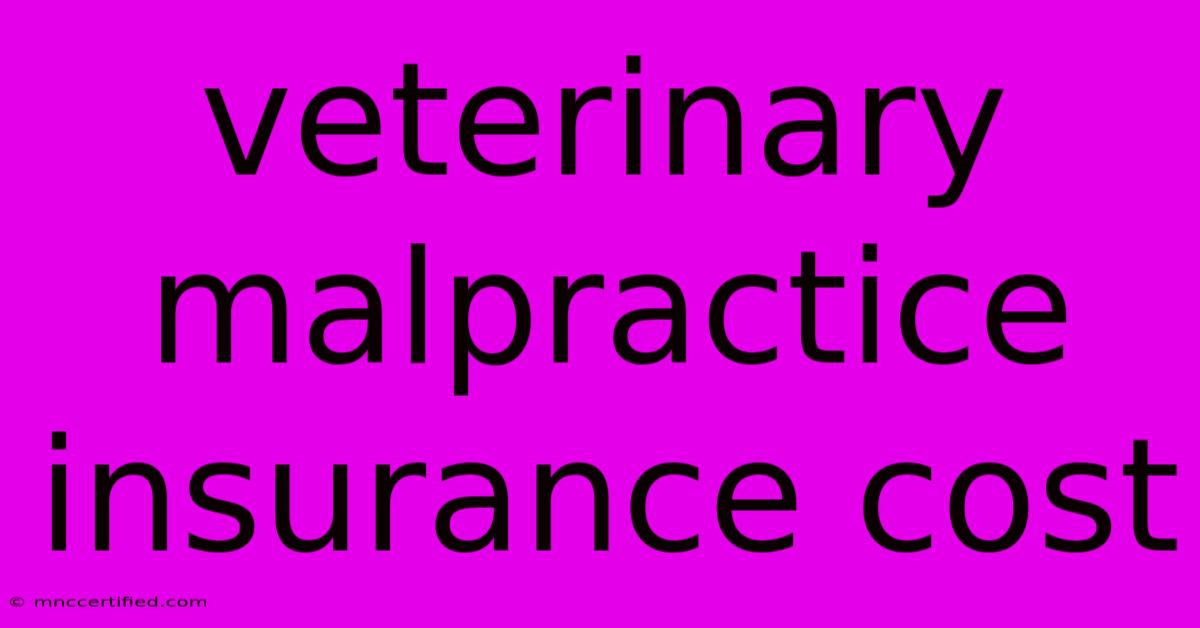Veterinary Malpractice Insurance Cost

Table of Contents
Understanding Veterinary Malpractice Insurance Cost: A Comprehensive Guide for Veterinarians
Veterinarians, like medical doctors, face the risk of legal action for mistakes or negligence in their practice. Veterinary malpractice insurance serves as a vital safety net, protecting you financially in the event of a lawsuit. However, the cost of this insurance can vary significantly depending on several factors. This guide aims to break down the key factors affecting the price of your veterinary malpractice insurance, allowing you to make informed decisions about your coverage.
Factors Influencing Veterinary Malpractice Insurance Cost
Several key factors influence the cost of veterinary malpractice insurance. Understanding these factors can help you identify areas where you can potentially control your premiums:
1. Specialty and Experience:
- Specialty: Veterinarians specializing in high-risk areas, such as surgery or emergency medicine, often face higher premiums due to the inherent nature of their practice.
- Experience: Newly licensed veterinarians generally face higher premiums compared to experienced professionals with established track records.
2. Location:
- State Laws: Each state has its own set of laws regarding veterinary malpractice claims. States with more stringent laws and higher average claim payouts tend to have higher premiums.
- Urban vs. Rural: Urban areas with higher population density and greater potential for litigation often have higher insurance costs.
3. Claims History:
- Previous Claims: Past claims, even if settled outside of court, can increase premiums. A clean claims history, however, can lower your insurance costs.
- Number of Employees: Practices with a larger number of employees may face higher premiums due to an increased potential for errors.
4. Coverage Limits:
- Policy Limits: Higher coverage limits, which provide greater financial protection in the event of a lawsuit, generally come with higher premiums.
- Types of Coverage: Choosing comprehensive coverage that includes professional liability, general liability, and even employment practices liability can impact the overall cost.
5. Deductible and Premium Payment Options:
- Deductible: A higher deductible, which you pay out-of-pocket before your insurance coverage kicks in, often results in lower premiums.
- Payment Schedule: Opting for annual premium payments rather than monthly installments can often lead to lower overall costs.
6. Risk Management Practices:
- Documentation and Record-Keeping: Maintaining meticulous records, adhering to established protocols, and documenting all patient interactions can help minimize the risk of malpractice claims and potentially lower premiums.
- Continuing Education: Staying up-to-date with the latest advancements in veterinary medicine through continuing education can demonstrate commitment to best practices and may lead to lower premiums.
- Patient Communication: Clear and transparent communication with clients about treatment plans, risks, and potential complications can help avoid misunderstandings and potential lawsuits.
Finding the Right Veterinary Malpractice Insurance: Tips and Strategies
- Compare Quotes from Multiple Providers: Don't settle for the first quote you receive. Explore various insurance providers and compare their coverage options and premiums.
- Consider Your Specific Needs: Analyze your practice's risk profile and determine the appropriate level of coverage.
- Negotiate with Your Provider: Don't be afraid to negotiate with your insurance provider. Highlight your clean claims history, strong risk management practices, and any relevant factors that might justify a lower premium.
- Explore Discount Programs: Some providers offer discounts for groups of veterinarians or those participating in certain professional organizations.
- Seek Professional Advice: Consult with an insurance broker specializing in veterinary malpractice coverage for personalized advice and guidance.
Conclusion
Veterinary malpractice insurance is essential for protecting your financial security in the event of a lawsuit. By understanding the factors that influence insurance costs and employing effective risk management practices, you can potentially minimize your premiums while ensuring adequate protection for your practice. Remember, the cost of insurance is an investment in your professional reputation and your financial well-being.

Thank you for visiting our website wich cover about Veterinary Malpractice Insurance Cost. We hope the information provided has been useful to you. Feel free to contact us if you have any questions or need further assistance. See you next time and dont miss to bookmark.
Featured Posts
-
Watch Real Madrid Vs Osasuna Live La Liga Stream
Nov 10, 2024
-
Precious Metals Investing For Dummies
Nov 10, 2024
-
Arcane Season 2 Review Of The Lavish Return
Nov 10, 2024
-
Weekend Ranked Rewards Gods Unchained
Nov 10, 2024
-
Jemimah Reflects On T20 World Cup Struggles
Nov 10, 2024